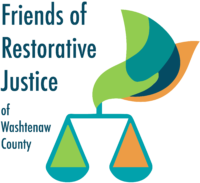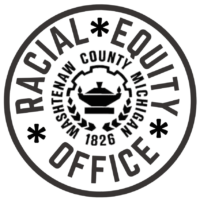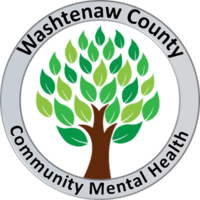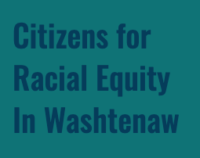Washtenaw Equity Partnership
2017
Friends of Restorative Justice
Friends of Restorative Justice of Washtenaw County undertakes a court watching study in Washtenaw County’s Juvenile Delinquency Court to “increase knowledge of the juvenile justice system in the county in order to have more meaningful discussions with members of that system regarding any areas that raised questions of efficacy or fairness to the victim, the offender and/or the community.”

2018
One Community
The Washtenaw County Board adopted the One Community: Advancing Racial Equity initiative which included “moving from departmental efforts around decreasing health disparity, or housing inequality, or issues around policing, into a broader, system-wide approach to addressing racial equity.” Washtenaw’s Equity Policy recognizes that “Many current inequities are sustained by historical legacies, structures, and systems that repeat patterns of exclusion. Without the intentionality stated in this Policy, inequitable outcomes linked to race, socio-economic status, and other identities will persist. The charge of the Policy is for all aspects of county government to address and implement strategies that target inequities that exist within the County organization, inclusive of all its services, resulting in equitable outcomes for all residents…”

2019
Joint Task Force on Jail and Pretrial Incarceration
The state launches the Joint Task Force on Jail and Pretrial Incarceration. Lieutenant Governor Gilchrist and Chief Justice McCormack wrote: “The problems that face our criminal justice system are decades in the making. It results from a 1980s crime wave that has long since passed, which led to a massive correctional system and these outdated practices continue to plague our system…Now is the time to review our systems, consider reforms, and reinvest in our communities. We can expand safety, stability, and wellness throughout Michigan with treatment programs, workforce development, and services for crime victims and the incarcerated. We can support law enforcement to ensure that they receive the resources they need to implement policies that improve public safety and reduce recidivism.”


CMH Critical Intervention Mapping
Washtenaw County Commuity Mental Health (CMH) holds two-day critical intervention mapping and action planning workshop to develop an action plan for improving the community response to justice-involved youth with behavioral health and trauma conditions.

2020
CREW Report
Citizens for Racial Equity in Washtenaw releases study of Washtenaw Circuit Court data to understand whether patterns of racial disparities exist in charging and sentencing.

2021
Prosecutor Transparency Project
Washtenaw County Prosecutor’s Office partners with Michigan Law, and Poverty Solutions at U-M in a ACLU funded project to: (1) conduct a robust study into racial disparities in Washtenaw County’s legal system, and (2) the identification, and publication, of performance and equity-based metrics.

Washtenaw County Prosecutor’s Office taps the Vera Institute of Justice to support an internal effort at data analysis, staff training, community engagement support, and policy expertise to expand its understanding of the criminal legal system’s history of racial injustice and guide the WCPO toward a more equitable future.

Washtenaw Equity Partnership
The Washtenaw County Board of Commissioners led a series of conversations with the county’s criminal legal institutions and CREW resulting in an agreement to engage in an inclusive process to identify inequities in Washtenaw’s juvenile and adult criminal legal systems and address those inequities. The Washtenaw Equity Partnership formally began in September 2021 with the first meeting of the 30+ member Working Group. The Working Group is made up of a balanced mix of community organizations, justice impacted people and county criminal legal institutions. It will meet monthly and oversee the work of six subcommittees through the end of 2022.
2022
In 2021, under the leadership of Chief Justice Bridget M. McCormack, the Michigan Supreme Court created the Michigan Judicial Council, the first-ever strategic planning process and strategic agenda for Michigan’s judicial system. In August 2022, the MJC released its Strategic Agenda (2022-2025) which contains 5 strategic goals to address over the next four years and a companion document, the Operational Plan for 2022 – 2023 which lays steps to be taken by July 2023. One or more of the WEP subcommittees’ work is consistent with and advances four of the five goals from the Court’s Strategic Agenda. The four goals are:
Strategic Goal #1: COURT FUNDING & TECHNOLOGY INFRASTRUCTURE (pg. 10 of the Strategic Agenda)
Michigan’s judicial system needs a technology infrastructure that connects and integrates courts across the state. A unified and integrated technology platform (including case processing and document and records management systems) will enhance information sharing, promote consistent data collection, analysis, and reporting, and will improve judicial and administrative decision-making.
Strategic Goal #2: THE PUBLIC’S EXPERIENCE & EFFECTIVE PROBLEM RESOLUTION (pg. 12)
The judicial branch is committed to improving and expanding effective dispute and problem resolution practices. This includes improving pretrial practices, expanding services to people experiencing mental health and substance abuse issues, using evidence based and other effective problem resolution practices to achieve effective outcomes for youth, families, and others who use the courts, to name a few. The seven strategies to provide more effective problem resolution are:
- Implement operational efficiencies through technology and simplify court procedures.
- Increase consistency in staffing levels, resources, procedures, and scheduling.
- Expand the use of case management practices that help resolve cases expeditiously.
- Develop a comprehensive continuum of court and community services to effectively address mental/behavioral health and substance abuse and addiction issues.
- Establish methods for collaborating and providing needed services (e.g., housing, education, mental health, substance abuse and addiction, rehabilitation) across justice and social service systems.
- Collaborate with partners to expand the availability of justice and community resources across the state, particularly in rural areas. Continue to expand uses of alternative dispute resolution methods and options (e.g., mediation, online dispute resolution, etc.).
- Be a leader in implementing justice and judicial system reforms consistent with the recommendations of Michigan’s Task Forces and Commissions and other national leaders and studies.
Strategic Goal #3: RACIAL & SOCIAL EQUITY (pg. 15)
All people who interact with the judicial system will be treated equitably and with dignity and respect. The Michigan Judicial Branch will work to eliminate racial and social inequities across the entire justice system, including from initial contact, while cases are pending, and as people exit the system. All people, especially people of color and disenfranchised and marginalized groups, will have similar experiences; they will experience a justice system that is free from bias, equitable, consistent, and predictable. Strategies for making Racial & Social Equity improvements include:
- Identify and study practices that may, or are known to, result in disparate treatment and share data to understand and educate about the magnitude and impacts of these practices.
- Eliminate practices that disadvantage specific groups and/or result in disparate treatment and outcomes; implement new practices that are just and equitable for all.
- Continue to improve and expand training and educational opportunities for judicial branch employees to build trust with all people, especially people of color and disenfranchised and marginalized groups, in collaboration with justice system and community partners.
- Build trust with all people, especially people of color and disenfranchised and marginalized groups, in collaboration with justice system and community partner
- Promote/advocate for diversity in justice system leaders, including judicial officers, prosecutors, law enforcement, etc. to ensure leaders & employees reflect the diversity in the communities they serve.
- Normalize conversations about racial and social equity across the judicial branch, with justice system and community partners, and within communities.
- Lead efforts to increase equity, consistency, and predictability within and across courts and with external partners.
- Implement consistent and predictable processes across all courts.
Strategic Goal #4: PUBLIC TRUST & UNDERSTANDING (pg. 17)
Remaining independent, being fair and impartial, responding to needs, being accountable for conduct and performance, and being transparent in the use of public resources are the bedrock for increasing understanding and building and maintaining the public’s trust and confidence. Strategies for making improvements in public trust and understanding include:
- Expand public outreach and education to promote confidence in the judicial branch, and educate about civics, democracy, the rule of law, and court procedures and practices.
- Collaborate with justice system and community partners to educate about and build trust and confidence in the judicial branch.
- Build upon and strengthen court performance metrics and reporting (e.g., public dashboard, etc.).
- Increase transparency while also protecting the privacy of court participants.
- Continue to improve and expand training and educational opportunities for the judiciary and court employees on professionalism, civility, ethics, etc.
- Continually solicit and listen to public/ court user feedback.
